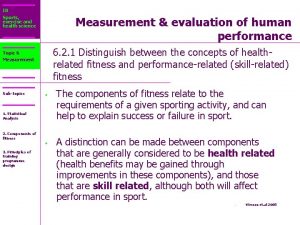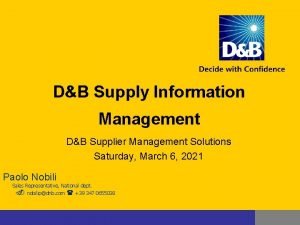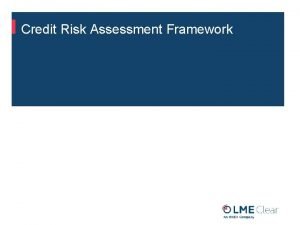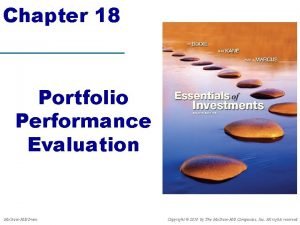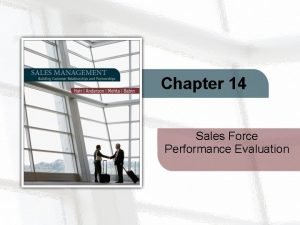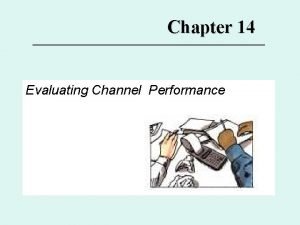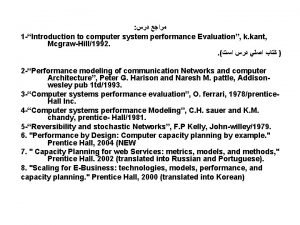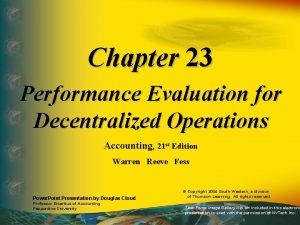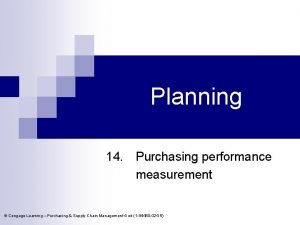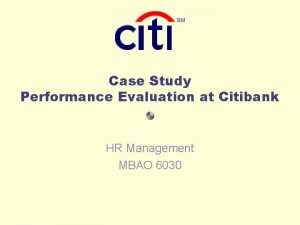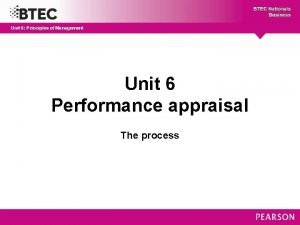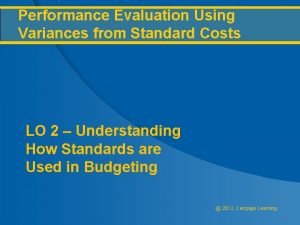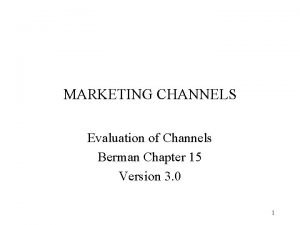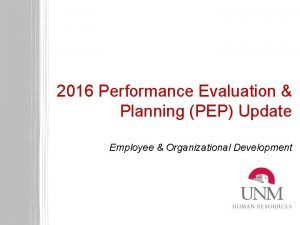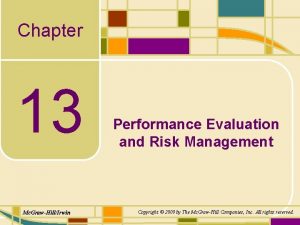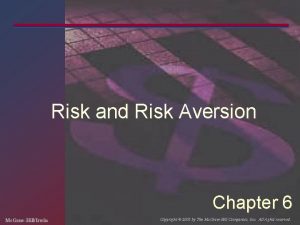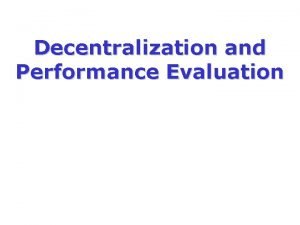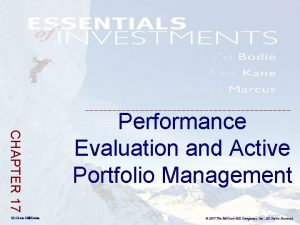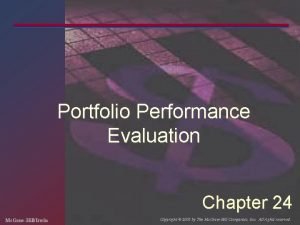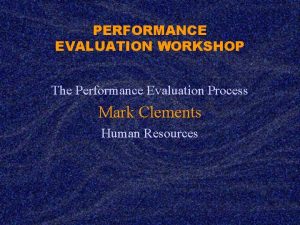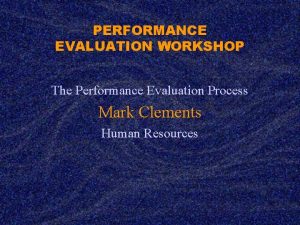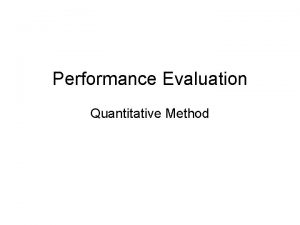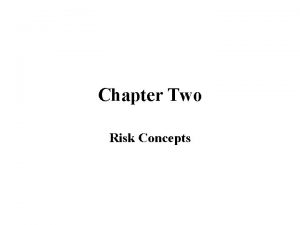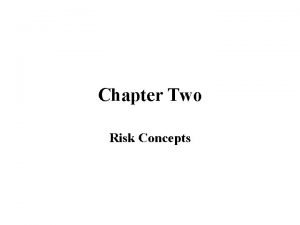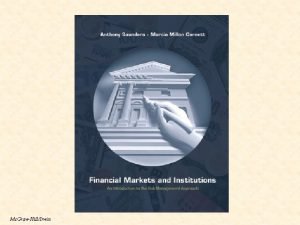Chapter 13 Mc GrawHillIrwin Performance Evaluation and Risk
































- Slides: 32

Chapter 13 Mc. Graw-Hill/Irwin Performance Evaluation and Risk Management Copyright © 2009 by The Mc. Graw-Hill Companies, Inc. All rights reserved.

It is Not the Return On My Investment. . . “It is not the return on my investment that I am concerned about. It is the return of my investment!” – Will Rogers 2

However, “We’ll GUARANTEE you a 25% return of your investment!” – Tom and Ray Magliozzi 3

Learning Objectives To get a high evaluation of your investments’ performance, make sure you know: 1. How to calculate three best-known portfolio evaluation measures. 2. The strengths and weaknesses of these three portfolio evaluation measures. 3. How to calculate a Sharpe-optimal portfolio. 4. How to calculate and interpret Value-at-Risk. 4

Performance Evaluation and Risk Management • Our goals in this chapter are to learn methods of – Evaluating risk-adjusted investment performance, and – Assessing and managing the risks involved with specific investment strategies 5

Performance Evaluation • Can anyone consistently earn an “excess” return, thereby “beating” the market? • Performance evaluation is a term for assessing how well a money manager achieves a balance between high returns and acceptable risks. 6

Performance Evaluation Measures • The raw return on a portfolio, RP, is simply the total percentage return on a portfolio. • The raw return is a naive performance evaluation measure because: – The raw return has no adjustment for risk. – The raw return is not compared to any benchmark, or standard. • Therefore, the usefulness of the raw return on a portfolio is limited. 7

Performance Evaluation Measures The Sharpe Ratio • The Sharpe ratio is a reward-to-risk ratio that focuses on total risk. • It is computed as a portfolio’s risk premium divided by the standard deviation for the portfolio’s return. 8

Performance Evaluation Measures The Treynor Ratio • The Treynor ratio is a reward-to-risk ratio that looks at systematic risk only. • It is computed as a portfolio’s risk premium divided by the portfolio’s beta coefficient. 9

Performance Evaluation Measures Jensen’s Alpha • Jensen’s alpha is the excess return above or below the security market line. It can be interpreted as a measure of how much the portfolio “beat the market. ” • It is computed as the raw portfolio return less the expected portfolio return as predicted by the CAPM. “Extra” Actual Return return CAPM Risk-Adjusted ‘Predicted’ Return 10

Jensen’s Alpha 11

Investment Performance Data and Portfolio Performance Measurement 12

Investment Performance Measurement on the Web 13

Comparing Performance Measures, I. • Because the performance rankings can be substantially different, which performance measure should we use? Sharpe ratio: • Appropriate for the evaluation of an entire portfolio. • Penalizes a portfolio for being undiversified, because in general, total risk systematic risk only for relatively welldiversified portfolios. 14

Comparing Performance Measures, II. Treynor ratio and Jensen’s alpha: • Appropriate for the evaluation of securities or portfolios for possible inclusion into an existing portfolio. • Both are similar, the only difference is that the Treynor ratio standardizes returns, including excess returns, relative to beta. • Both require a beta estimate (and betas from different sources can differ a lot). 15

Sharpe-Optimal Portfolios, I. • Allocating funds to achieve the highest possible Sharpe ratio is said to be Sharpe-optimal. • To find the Sharpe-optimal portfolio, first look at the plot of the possible risk-return possibilities, i. e. , the investment opportunity set. Expected Return × × × × Standard deviation 16

Sharpe-Optimal Portfolios, II. • The slope of a straight line drawn from the risk-free rate to where the portfolio plots gives the Sharpe ratio for that portfolio. Expected Return A × Rf Standard deviation • The portfolio with the steepest slope is the Sharpe-optimal portfolio. 17

Sharpe-Optimal Portfolios, III. 18

Example: Solving for a Sharpe-Optimal Portfolio • From a previous chapter, we know that for a 2 -asset portfolio: So, now our job is to choose the weight in asset S that maximizes the Sharpe Ratio. We could use calculus to do this, or we could use Excel. 19

Example: Using Excel to Solve for the Sharpe-Optimal Portfolio Suppose we enter the data (highlighted in yellow) into a spreadsheet. We “guess” that Xs = 0. 25 is a “good” portfolio. Using formulas for portfolio return and standard deviation, we compute Expected Return, Standard Deviation, and a Sharpe Ratio: 20

Example: Using Excel to Solve for the Sharpe-Optimal Portfolio, Cont. • Now, we let Excel solve for the weight in portfolio S that maximizes the Sharpe Ratio. • We use the Solver, found under Tools. Well, the “guess” of 0. 25 was a tad low…. 21

Investment Risk Management • Investment risk management concerns a money manager’s control over investment risks, usually with respect to potential short-run losses. • We will focus on what is known as the Value-at-Risk (Va. R) approach. 22

Value-at-Risk (Va. R) • Value-at-Risk (Va. R) is a technique of assessing risk by stating the probability of a loss that a portfolio may experience within a fixed time horizon. • If the returns on an investment follow a normal distribution, we can state the probability that a portfolio’s return will be within a certain range, if we have the mean and standard deviation of the portfolio’s return. 23

Example: Va. R Calculation • Suppose you own an S&P 500 index fund. • What is the probability of a return of -7% or worse in a particular year? • That is, one year from now, what is the probability that your portfolio value is down by 7 percent (or more)? 24

Example: Va. R Calculation, II. • First, the historic average return on the S&P index is about 13%, with a standard deviation of about 20%. – A return of -7 percent is exactly one standard deviation below the average, or mean (i. e. , 13 – 20 = -7). – We know the odds of being within one standard deviation of the mean are about 2/3, or 0. 67. • In this example, being within one standard deviation of the mean is another way of saying that: Prob(13 – 20 RS&P 500 13 + 20) 0. 67 or Prob (– 7 RS&P 500 33) 0. 67 25

Example: Va. R Calculation, III. • That is, the probability of having an S&P 500 return between -7% and 33% is 0. 67. • So, the return will be outside this range one-third of the time. • When the return is outside this range, half the time it will be above the range, and half the time below the range. • Therefore, we can say: Prob (RS&P 500 – 7) 1/6 or 0. 17 26

Example: A Multiple Year Va. R, I. • Once again, you own an S&P 500 index fund. • Now, you want to know the probability of a loss of 30% or more over the next two years. • As you know, when calculating Va. R, you use the mean and the standard deviation. • To make life easy on ourselves, let’s use the one year mean (13%) and standard deviation (20%) from the previous example. 27

Example: A Multiple Year Va. R, II. • Calculating the two-year average return is easy, because means are additive. That is, the two-year average return is: 13 + 13 = 26% • Standard deviations, however, are not additive. • Fortunately, variances are additive, and we know that the variance is the squared standard deviation. • The one-year variance is 20 x 20 = 400. The two-year variance is: 400 + 400 = 800. • Therefore, the 2 -year standard deviation is the square root of 800, or about 28. 28%. 28

Example: A Multiple Year Va. R, III. • The probability of being within two standard deviations is about 0. 95. • Armed with our two-year mean and two-year standard deviation, we can make the probability statement: Prob(26 – 2 28 RS&P 500 26 + 2 28) . 95 or Prob (– 30 RS&P 500 82) . 95 • The return will be outside this range 5 percent of the time. When the return is outside this range, half the time it will be above the range, and half the time below the range. • So, Prob (RS&P 500 – 30) 2. 5%. 29

Computing Other Va. Rs. • In general, for a portfolio, if T is the number of years, Using the procedure from before, we make probability statements. Three very useful ones are: 30

Useful Websites • www. stanford. edu/~wfsharpe (visit Professor Sharpe’s homepage) • www. morningstar. com (comprehensive source of investment information) • www. gloriamundi. org (learn all about Value-at-Risk) • www. riskmetrics. com (check out the Knowledge Center) • www. andreassteiner. net/performanceanalysis (Investment Performance Analysis) • www. finplan. com (Fin. Plan – financial planning web site) 31

Chapter Review • Performance Evaluation – Performance Evaluation Measures • The Sharpe Ratio • The Treynor Ratio • Jensen’s Alpha • Comparing Performance Measures • Sharpe-Optimal Portfolios • Investment Risk Management and Value-at-Risk (Va. R) 32
 Credit risk market risk operational risk
Credit risk market risk operational risk Progress and performance measurement and evaluation
Progress and performance measurement and evaluation Progress and performance measurement and evaluation
Progress and performance measurement and evaluation Measurement and evaluation in human performance 5e download
Measurement and evaluation in human performance 5e download Vertical jump adalah
Vertical jump adalah Residual risk and secondary risk pmp
Residual risk and secondary risk pmp Business risk and financial risk leverage
Business risk and financial risk leverage Relative risk calculation
Relative risk calculation Attributable risk
Attributable risk D&b supplier evaluation risk rating
D&b supplier evaluation risk rating Credit risk evaluation framework
Credit risk evaluation framework Computer architecture performance evaluation methods
Computer architecture performance evaluation methods Portfolio performance evaluation problems
Portfolio performance evaluation problems Sales force evaluation process
Sales force evaluation process Criteria for evaluating performance of channel members
Criteria for evaluating performance of channel members Computer performance evaluation
Computer performance evaluation Usmc comparative assessment
Usmc comparative assessment Direct support professional performance evaluation
Direct support professional performance evaluation Performance evaluation for decentralized operations
Performance evaluation for decentralized operations Evaluating purchasing performance
Evaluating purchasing performance Citibank performance evaluation
Citibank performance evaluation Housekeeping appraisal comments
Housekeeping appraisal comments Principles of performance appraisal
Principles of performance appraisal Stronge leader effectiveness performance evaluation model
Stronge leader effectiveness performance evaluation model Performance evaluation using variances from standard costs
Performance evaluation using variances from standard costs Library staff performance evaluation
Library staff performance evaluation Channel performance evaluation
Channel performance evaluation Performance evaluation model
Performance evaluation model Da form 7222-1
Da form 7222-1 Pep performance evaluation
Pep performance evaluation Risk projection attempts to rate each risk in two ways
Risk projection attempts to rate each risk in two ways Risk management avoidance
Risk management avoidance How to calculate relative risk
How to calculate relative risk



